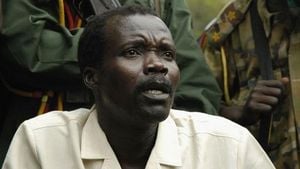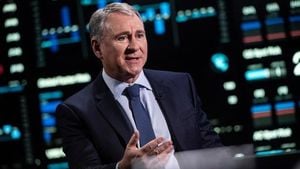Economic Strain of Russia's War Effort
More than 1,000 days have ticked by since Russia initiated its full-scale invasion of Ukraine, and the economic ramifications are beginning to hit home for everyday Russians. With prices for basic goods like milk, butter, and potatoes rising sharply and government strategies shifting to prioritize military expenditure, the fabric of Russian society faces significant strain.
Just this past October, the Central Bank of Russia raised its key interest rate to 21%, the highest it has been in over two decades, as inflation continues to soar. Russia’s annual inflation rate was reported at 8.5% last October—well above the Central Bank's ambitious target of 4%. Prices for staples keep climbing, with butter now costing up to 200 rubles (nearly $2) for just 200 grams, reflecting increases of around 30% since last December.
This inflationary pressure is mirrored up and down the economic spectrum, leading some shopkeepers to tighten security, fearing thefts stemming from the increased cost of everyday items. Video footage from a recent theft at Dairy Place, a store in Yekaterinburg, showed assailants leaving with arms full of butter—a reflection of just how valuable these products have become. The owner remarked on social media, "Butters are now like gold."
Stanislav, another resident of Moscow, echoed the sentiments of frustration many Russians feel as they navigate these economic changes. He pointed to the troubling reality where many of his peers are forced to downgrade to lower-quality goods and postpone major purchases, hoping for the storm to pass. "The cost of basic foods has been growing for the last three years; it is getting worse day by day," he said.
All this volatility is putting the Russian economy at risk of collapse. Economists and business insiders now openly describe market conditions as dead, plagued by rising corporate bankruptcies and labor shortages. The current corporate climate is reflected by the remarks of Sergei Chemezov, the head of Rostec, Russia’s state-run industrial conglomerate. Chemezov urged for more supportive monetary policies, defending against the sooner-than-expected fallout from skyrocketing interest rates which have caused the economy to overheat.
Curiously, the government has boasted about economic growth stimulated by military expenditures, reporting GDP growth of 3.6% and projecting another growth of 3.9% for the current year. But this growth is misleading, as it relies heavily on militarized investment rather than sustainable economic fundamentals. With high interest rates dampening investments across the board, businesses face increasing pressure to either cut back on expansion or risk doing so at unsustainable costs.
Meanwhile, corporate debts have surged, placing immense financial pressure on companies seeking loans to invest or to offer higher wages to attract workers. Notably, men who enlist for military service can now earn sums equaling one year’s salary, drawing many away from the labor market and exacerbated manpower shortages across sectors.
The combination of high inflation and increasing debts casts doubt on the robustness of Russia’s economy, with concerns about looming stagflation becoming more prevalent. High inflation paired with stagnant economic growth translates to fewer opportunities and dwindling consumer confidence—a toxic combination for any economy. Janis Kluge, from the German Institute for International and Security Affairs, highlighted, "For almost three years, it seemed like everybody was getting rich in this war. But now, it becomes clear…the price to pay is becoming apparent."
This deteriorative situation, combined with the backdrop of relentless Western sanctions, cuts Russia off from several global markets and limits access to advanced technology, which are key to both energy production and other manufacturing sectors. Though initially dismissed by the Kremlin, the ramifications of these sanctions are now evident as the economy confronts the limits of its military-first focus.
President Vladimir Putin has attempted to deflect blame elsewhere during this economic turmoil, emphasizing the role of "unfriendly countries" and external pressures as culprits for rising prices, denying the narrative of "butter for guns." While many everyday Russians have linked the struggles of their wallets to the Ukraine conflict, open criticism remains dangerous; dissenting voices can lead to punishment under laws aimed at suppressing statements against the military.
Despite the economic fallout, there is no significant sign of mass outrage against the government's handling of the conflict. Residents have shown signs of adapting to the increased prices, but the burden falls heavier on those living in rural areas and small towns, far from the comparatively sheltered lives of urban dwellers.
The Kremlin has endeavored to alleviate some immediate issues like product shortages through counter-measures, such as eliminating import duties on eggs when prices surged last year. Importing eggs from "friendly" nations and implementing widespread price control mechanisms on essentials could signal just how precarious the situation has become.
Analysts suggest Russia’s economy is now at a turning point, with high interest rates burning through business confidence at alarming rates. With businesses reluctant to invest under current economic conditions and geopolitical tensions still running high, expectations for recovery remain bleak for the foreseeable future.
The Russian economy now stands at a crossroads, balancing the need for defense production against the livelihoods of its citizens who are feeling the pinch with every passing day. While some individuals continue to blame foreign nations for the country's inflationary woes, the reality is growing more apparent: Russia’s war economy is facing the consequences of prioritizing militarized spending over sustainable economic growth.



